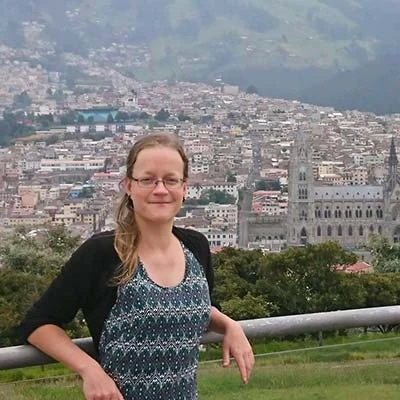
The Ecuadorian province of Esmeraldas is known to tourists mainly because of its beach and seaside resorts like Atacames, Mompiche or Tonsupa south of the city of Esmeraldas. These places are easy to reach, for example, it takes only about five to six hours to drive from Quito to Atacames.
The northern part of the province, on the other hand, is almost undiscovered, which is partly due to its proximity to Colombia and the associated reputation of being dangerous due to drug conflicts. But is that really the case?
I had heard different opinions about the dangerousness. Everybody advised me not to stay longer in the city of Esmeraldas. But I did not intend to do so. Rather, I wanted to get to know the rural area and the small towns. As accommodation I had chosen the Quinta el Mamey. Explore with me THE UNEXPLORED NORTH OF ESMERALDAS – A REGION WORTH SEEING.
Arrival to Quinta el Mamey
Overnight I took the bus from Quito to Esmeraldas and arrived there before sunrise. If you are traveling during the day, in a round trip or by rental car, it is worthwhile to plan stops at the Mitad del Mundo and in Mindo.
From the bus terminal of Esmeraldas to Quinta el Mamey it is about a 40 minute bus ride along the coast. By car it should be about 20 – 30 minutes.
Arriving to the the small village of Peñas Blancas, a sign indicated the entrance to the Quinta. I was kindly welcomed by the owner, a Swiss woman who runs the accommodation together with her Ecuadorian husband, as well as some dogs.
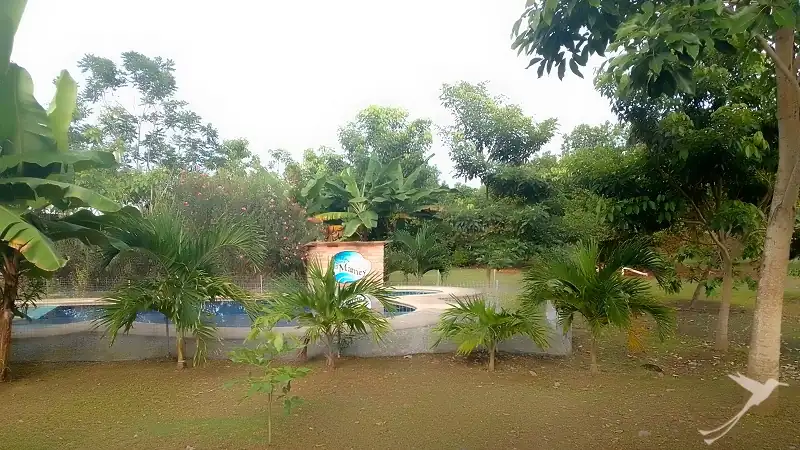
Vegetarian soup in Palestina and relaxing on the beach and in the pool
After settling in and exploring the pretty property a bit, I headed out for a walk on the beach. The beach, which is dark due to volcanic minerals, lies behind some mangroves and, since it was low tide, was quite wide.
Personally I´m not someone who can stand it for a long time on beaches or even lie on a towel for hours and do nothing. If you like that kind of activity, this beach is perfect for you, because you won’t meet a soul for a long time. But also for me there was a lot to discover – flotsam and jetsam formed by the sea, fishing boats and mangroves that border the beach in northern and southern direction as far as the eye can see. Crabs scurried by and from time to time a seabird settled on the sand or the woods.
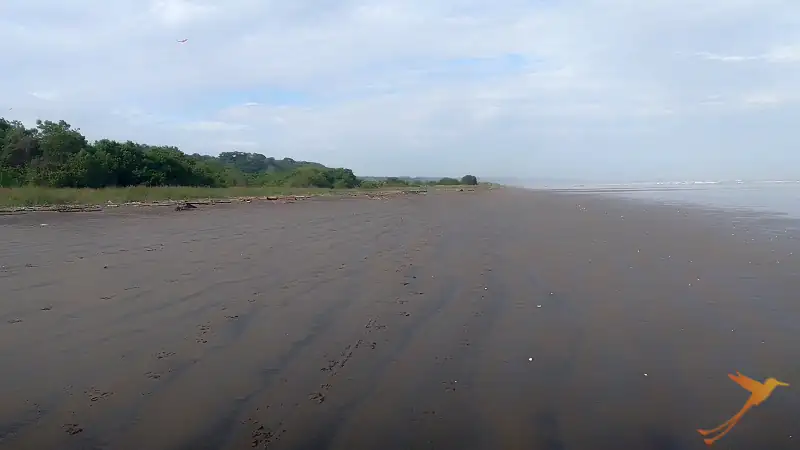
I then headed briefly to the nearest larger town, Palestina. Here you have the possibility to withdraw money and buy food and other things for daily use. To my delight, I also found a restaurant that happened to have vegetarian soup.
Back at Quinta el Mamey, I conversed with the owners and enjoyed the pool with hydro-massage. The Quinta is not only an accommodation, but at the same time a small farm, where various agricultural and culinary plants are grown ecologically and according to permaculture principles. The products are used in the restaurant and for personal consumption, and the plant diversity attracts many useful insects and also hummingbirds and other bird species. In addition, the owners of the Quinta have created the Amigos Arbolito (“Tree Friends”) project. The goal is to protect the coastal mangrove forests, reforest and open areas and generally promote the sustainability of the region, also by involving the local population. The project can be supported through donations and tree sponsorships.
In the evening I went again to the beach, which was now only a narrow strip due to the rising tide, to watch the sunset. There was a spectacular play of colors from orange to dark purple, reflected in the calm sea and dotted with absorbent cotton clouds.
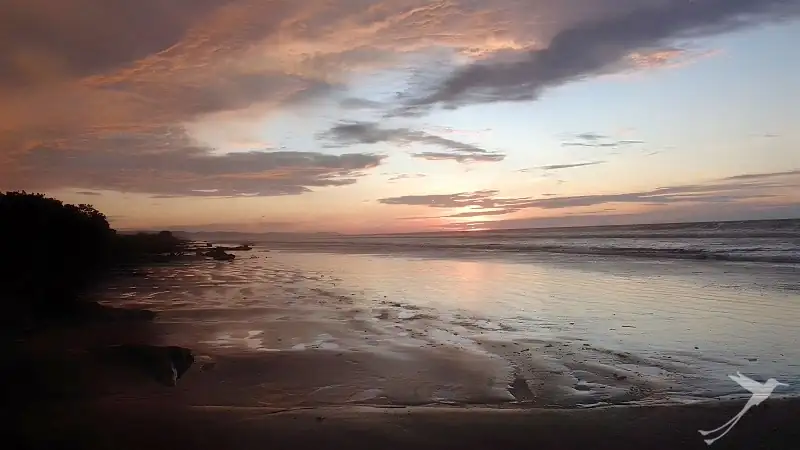
Archaeological excavations at La Tolita Pampa de Oro
The next day I had originally planned to explore more small beach towns further north by regional bus. The final stop of the bus I boarded was La Tolita. After doing a little research on the way, I spontaneously decided to drive to the final stop and explore the area there a little. As in the rest of the province of Esmeraldas, the population here is Afro-Ecuadorian and I stood out as a Central European here now particularly. So I was looked at partly a bit curious but always friendly and benevolent and could have the one or other interesting conversation, because the bus ride lasted about 1.5 hours. I asked about the crime and the bad reputation of the province and again it was confirmed to me that the problems and conflicts take place primarily in the city. In the countryside and in the smaller towns, life is still comparatively peaceful and quiet.
In the hot, humid heat of midday, the bus finally arrived in La Tola. The town is surrounded by mangrove forests on the banks of the Santiago River just before it flows into the Pacific Ocean. From the dock, various small boats and ferries travel along the arms of the river to the villages, which can only be reached by water. I made the acquaintance of an elderly gentleman who sells breads and other pastries in the area. I later learned that in addition to being a baker, he also works occasionally as a local guide and makes furniture from mangrove wood. He recommended to me to visit La Tolita Pampa de Oro, an archaeologically significant site on the other side of the river.
So, together with some others, I took the small ferry boat, which was fortunately covered, because the sun was burning fiercely. Since just low water prevailed, the boat drove a detour over a side arm of the river. This gave me a longer opportunity to admire the riverbank lined with mangroves and coconut palms.
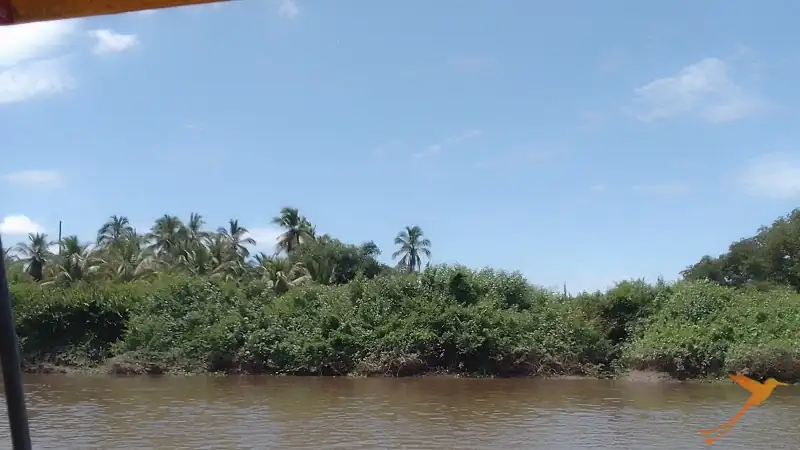
Arriving in La Tolita Pampa de Oro, I visited a tiny museum with ceramic findings from the area. The man in charge, an ethnologist who must be quite famous, had already participated in excavations in Peru and other parts of Ecuador. He told me the amazing story of La Tolita, where gold jewelry and ceramics are still found today. The findings can be dated back to about 500 BC to about 500 AD at the time of the La Tola culture. The famous Sol de Oro (“Gold Sun”) with its 48 rays in the shape of snakes was also found here. This artifact is now the symbol of the Central Bank of Ecuador and part of the country’s cultural heritage.

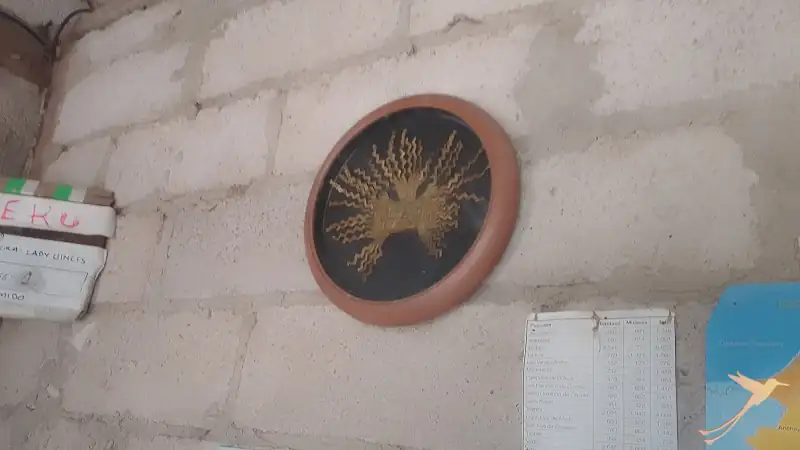
“La Tola” means hill or elevation. On the one hand, they served to elevate the dwellings to protect them from the surge of the river and, on the other hand, they were burial mounds. Today, the tolas are mostly overgrown with grass, but a closer look still reveals a large number of pieces of pottery, parts of figurines and bone remains – an archaeological treasure trove without barriers or guards. There are also many pieces of pottery still to be found on the riverbank.
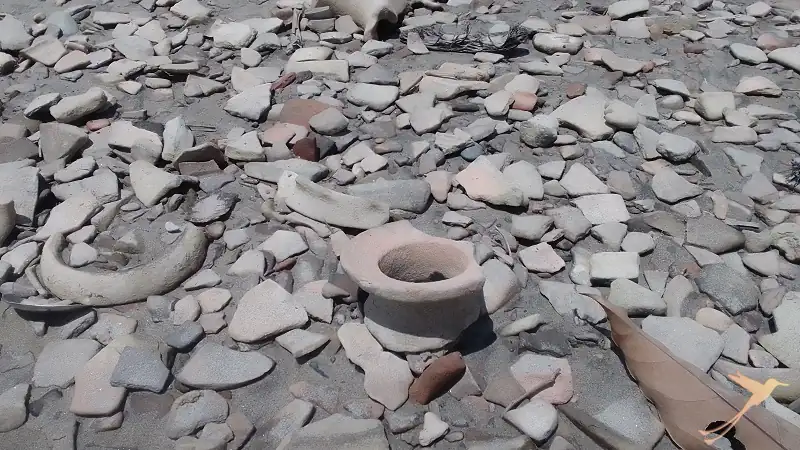
It was a surprising and very interesting excursion. I took a small boat back to La Tola. At high tide and with full speed we got properly splashed wet, but since it was raining in the meantime – this boat had no roof – it didn’t make any difference anymore, it was rather a welcome cooling.
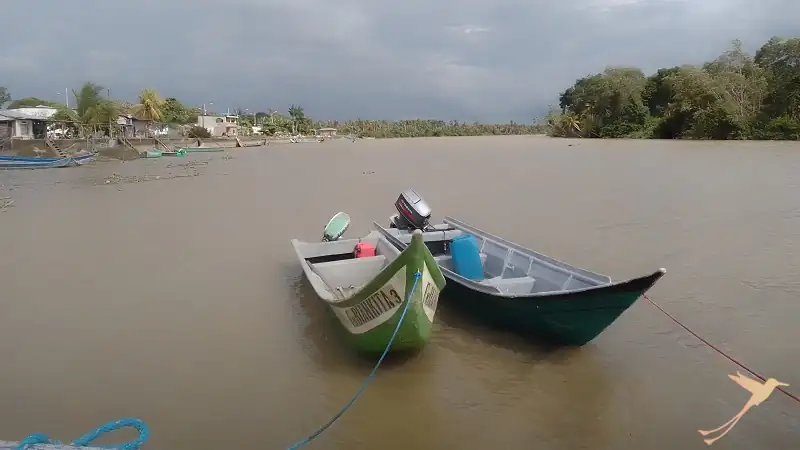
On the way back to Quinta el Mamey I made a short stop at the seaside resort Las Peñas. The place was nice with a long beach and many, many restaurants but didn’t excite me too much. La Tola and La Tolita Pampa de Oro had been much more interesting for me. After a long day full of exciting impressions I finally arrived back at the accommodation and took the bus back to Quito the next morning.
What to take and consider when visiting the north of Esmeraldas
The climate on the coast of Esmeraldas can be hot and humid, depending on the season, so you should bring light clothing and sunscreen. Also a towel to dry yourself Is a good idea. For buses or even some stores, a cardigan or sweater is recommended, since the air conditioning systems are sometimes set quite cool.
For rain showers, which can sometimes come quite spontaneously, you can take an umbrella or thin (!) rain cape with you as a precaution – or just stand under it and wait for it to pass.
Outdoors, you should always apply sunscreen and wear a headgear, because even on cloudy days, light-skinned Central Europeans burn quite easily.
Mosquito repellent is definitely recommended when sitting outside in the evening or when staying near the mangroves.
It is advisable to always have some cash with you, including small change, as change is often a problem and you can rarely pay by card in small towns. ATMs are only available in medium or larger towns.
Otherwise, the same applies as in the rest of the country: compare prices (e.g. for cab rides) or find out in advance, be attentive but not afraid, inform yourself but don’t let rumors spoil the joy of traveling, because the north of Esmeraldas is absolutely worth seeing.







